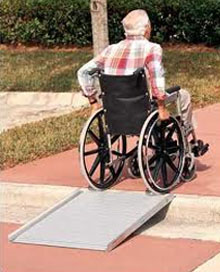
Access Ramps Resources
- Home
- Types of Access Ramps
- Access Ramps for Disabled
- Access Ramps for Sale
- Access Ramps for Wheelchairs
- Ada Access Ramps
- Building Access Ramps
- Disability Access Ramps
- Disabled Access Ramps
- Disabled Access Ramps Regulations
- Easy Access Ramps
- EZ Access Ramps
- FAQs Access Ramps
- Handicap Access Ramps
- Handicapped Access Ramps
- Lightweight Access Ramps
- Modular Access Ramps
- Portable Access Ramps
- Portable Disability Access Ramps
- Vehicle Access Ramps
- Wheelchair Access Ramps
Handicapped Access Ramps
If you are in charge of a project to build handicapped access ramps, it is important to prepare yourself with sufficient relevant knowledge. You will need to understand the accessibility regulations that are imposed by the state in which the handicapped access ramps will be installed. As a first point of reference, contact the local branch of U.S Department of Justice Office, or the local representative of the Americans with Disabilities Act advisor. It is a good idea to have the ADA handbook close to hand. Should you not be able to contact these organizations, for whatever reason, get a copy of the Federal Register Part III which will give you all the information on the correct handicapped access ramp design and specifications you need to know, it will also give you the correct dimensions for the ramp allowed to be built.
Installing ramps at home
If you are planning to install handicapped access ramps in the home, there are no legal restrictions. However, taking a look at how to install a ramp in a public place and following the recommendations closely will be good practice. In a single family residence, the best width dimensions for your ramp will be a minimum of 36 inches; 48 inches are better, if space permits. It is important to make sure that the landing, either at the top or the bottom of the handicapped access ramps, are level to avoid the danger of a bumpy and potentially risky arrival. The most important factor to bear in mind is that a 60 inch long landing needs to be built in for every 30 inches of elevation.
For handicapped access ramps, landings need to be as wide as the ramp itself. Our American legislation requires that landings have a minimum set of dimensions of 60 inches by 60 inches, should the ramp change directions on landing. Next, you will need to turn your attention to the guard rails. Guard rails need to be installed on both sides of the ramp, assuming there is not a wall on one side. Even if there is a wall, handles should be fitted at regular intervals to ensure that if wheelchair users find themselves in difficulty on the handicapped access ramps, they can stop their wheelchair running out of control.
Fitting the handrails correctly
Handrails need to be fitted facing inwards for easy access for handicapped access ramps users. The top of the handrail needs to be set at a height of 34” to 38” from the ramp surface. A number of handicapped access ramps installers recommend installing a second set of handrails at about 20” height from the ramp surface.
The best advice for the fitting of the handrails is that they should offer a clear 1½” clearance from the surface on which they are mounted. This is a good practice to follow, as wheelchair users of handicapped access ramps may also suffer from reduced movement in their hands and therefore need an easier access to the safety handles.
You need to take note that the maximum slope of handicapped access ramps should be 1:12; however handicapped access ramps with a slope of 1:16 or 1:20 are appreciated by wheelchair users, as they are easier to navigate. These ratios mean that for every inch of incline, the ramps can have a length of no less than 12, 16 or 20 inches.
